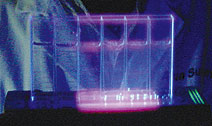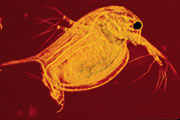

Posted on 10/31/2003 4:23:37 AM PST by snopercod
After 9/11, the testing to detect contaminants in water supplies abruptly moved from an arcane laboratory exercise to a front-burner item in the forefront of the rapidly developing homeland security market. One of the biggest newsmakers in the emerging marketplace may be a tiny organism called daphnia.
The tiny water fleas–typically about 3 mm long–are commonly used as bioindicators. Now, Aqua Survey Inc. is unveiling a detection kit that uses daphnia to quickly determine whether ricin, cyanide, VX, botulinium toxin and other toxins are present in a municipal water supply. The Flemington, N.J.-based firm presented slides and film of daphnia in action at an Oct. 20 homeland security field day in Columbus, Ohio, sponsored by the U.S. Environmental Protection Agency and Battelle Memorial Institute. "The daphnia were a real crowd-pleaser," says Katy Delaney, Battelle spokesperson.
Battelle has been testing seven different monitoring technologies this summer to see how well they could detect a variety of agents that terrorists might dump in a water supply. Standard testing methods take from 24 to 96 hours. With an eye to the reality of terrorism today, EPA wants to cut the time to an hour and wants portable test kits.
Besides daphnia, technologies evaluated by Battelle employ bioluminecense, fluormetric biomarkers or changes in dissolved oxygen levels. Vendors supply their kits, some of which are already on the market, for independent analysis under EPA’s Environmental Technology Verification program. The lab has already provided results to each vendor. The next round of reports will go to EPA for review and comment. After results go to stakeholders–competitors, water treatment officials and responders in police, fire and emergency medical departments, they will be made public in six weeks.
"We’re not trying to say one is better than another," says Battelle researcher Ryan James. "We’re just running each kit against a number of toxic solutions and publishing the data."
 |
 |
| GLOWING REPORT. Healthy Daphnia shine but those exposed to toxic water samples do not. | |
Kenneth Hayes, president of Aqua Survey, says he conceived the IQ Toxicity Test kit a few years ago after ordering a $16,000 unit from a competitor. "I felt like we could devise something that worked better for a lower cost," he says.
The daphnia are fed a sugar solution before exposure to samples. Healthy daphnia emit a luminescent glow; those exposed to toxics keep swimming, but do not glow. "We detected every toxicant," says Hayes. "I don’t think the others can say that." The IQ kit will sell for about $2,400, he says. Replacing daphnia cultures monthly will add $400, he adds.
Disclaimer: Opinions posted on Free Republic are those of the individual posters and do not necessarily represent the opinion of Free Republic or its management. All materials posted herein are protected by copyright law and the exemption for fair use of copyrighted works.